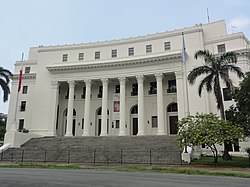 The museum in 2024 | |
| Coordinates | 14°35′07″N120°58′51″E / 14.58528°N 120.98083°E |
|---|---|
| Type | Anthropology museum |
| Public transit access | |
| National Museum of the Philippines | |
The National Museum of Anthropology (Filipino : Pambansang Museo ng Antropolohiya), formerly known as the Museum of the Filipino People (Filipino : Museo ng Lahing Filipino), is a component museum of the National Museum of the Philippines which houses ethnological and archaeological exhibitions. It is located in the Agrifina Circle, Rizal Park, Manila adjacent to the National Museum of Fine Arts building.
Contents
- Current galleries and offices
- Ground floor
- Second floor
- Third floor
- Fourth floor
- Fifth floor
- See also
- References
- External links
Built c. 1916 –1918 from a neoclassical design by Canadian-American architect Ralph Harrington Doane when he was consulting architect to the Philippine government, [1] the building formerly housed the Department of Finance. [2] It also houses the wreck of the San Diego , ancient artifacts, and zoology divisions.















